
Other Medical Conditions
What is botulism?
- ~ Caused by a neurotoxin released by clostridium botulism
- ~ Related to ingestion of contaminated food – raw meat or dead animals
- ~ Inhibits the release of neurotransmitters at the junction between nerves and muscles – inhibiting signal transmission
- ~ Causing paralysis
Signs and symptoms?
- Progressive muscle weakness
- Starts at hind limbs and progresses to front limbs and neck
- Respiratory distress
Treatment options:
- Veterinary care
- ~ Supportive care – depending on symptoms
- ~ Antibiotics
What is exercise?
- An activity requiring physical effort, carried out specially to sustain or improve health and fitness.
- It is a movement that requires your body to work at a greater intensity than your usual level of activity.

What is rehabilitation and therapeutic exercise?
- Exercises that are involved in the process of regaining full function following injury.
- Focus on restoring strength, flexibility, endurance, and power.
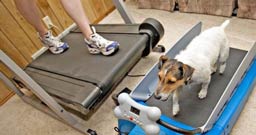
Effects of exercise
- Cardiorespiratory system – increases O2 in the body.
What is rehabilitation and therapeutic exercise?
- Exercises that are involved in the process of regaining full function following injury.
- Focus on restoring strength, flexibility, endurance, and power.

Cardiovascular system
- Increase heart muscle size – better contraction increases ability to delivery oxygen.
- Reduces heart rate and increase stroke volume.
- Decrease in heart rate recovery period.
- Reduction in Lactic acid build up.
Musculoskeletal system
- Increased bone density – (weightbearing exercise)
- Increase in muscle mass and strength (resistance training)
- Normalize muscle tone.
- Improves joint ROM.
- Improves nutrition to the joint

Physiotherapy aims for rehabilitation exercises
- Increase or maintain joint ROM
- Improve or maintain general mobility and function
- Improve circulation
- Reduce pain
- Promote tissue healing
- Improve balance and coordination
- Improve muscle function and strength
- Restore normal movement patterns
- Promote relaxation
- Reduce strength
- Manage weight
Rehabilitation program includes the following depending on your dog and their needs
We will give you examples of exercises for each area in the next few weeks
- Muscle conditioning and strengthening
- Flexibility and suppleness
- Proprioception
- Balance and Coordination
- Endurance
- Motor relearning
- Functional exercises
- Cardio – respiratory fitness
- Return to sport
FIRST THINGS FIRST
A WARM UP!!
- Prepares the body for exercise
- Reduces risk of injury
- Reduces overloading
- Improves speed of muscle contraction

Warm up example
- 10 sit stands
- 5 cookie stretches to hip each way
- It all depends on the specific dog in questions so be sure to ask your physio.
COOL DOWN
- Helps body recover from exercise (lowers heart rate gradually)
- Helps remove waster products from muscles

Cool down example
- 10 stretches to hip each way
- Sternal lifts x10
- Paw x10
- Gentle massage 5minutes – will be coming in one of our talks so keep an eye out
Muscle Strengthening
The muscle’s ability to exert force.
Why?
To improve the muscle power
To improve stability around a specific joint
To improve functional ability

Muscle Endurance
The muscles ability to sustain contraction or perform repeated contractions.
Why?
- Decrease risk of injury
- Address functional ability
How?
- Increase amount of repetitions without increasing the resistance.
- Increase the amount of time
Soft tissue extensibility and joint mobility
Why?
- Increase ROM
- Reduce stiffness
- Increase functional ability
How?
- Free active movements
- Passive movements
- Stretches

Proprioception
Unconscious perception of movement and body part position.
Why?
- Improve balance and coordination
- Prevent further/ new injury
How?
- Weight bearing ex’s
- External input to limbs (different textures)
- Unstable surfaces


Balance and Coordination
Why?
- Improve functional ability
- Prevent further/ future injury
- Target core muscle
How?
- Active and active resisted movements
- Unstable surface
- Stepping over objects
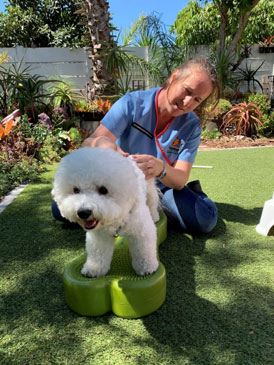
What are seizures?
- Physical manifestation of uncontrolled electrical activity in the brain.
- Can get generalized or partial seizures
- It can be very distressing for the pet and owner.

Causes:
- Intoxication
- Kidney disease
- Liver disease
- Brain malformations
- Tumours
- Genetic predisposition
Signs and symptoms?
- Loss of consciousness
- Involuntary repetitive movements
- Urination
- Salivation
- Defecation
- Muscle spasms/tremors
- Abnormal sensations
- Hallucinations
- Disorientation and confusion after the seizure
- Can lead to temporary paralysis and muscle weakness
Treatment options:
- Treatment of underlying cause
- Anti-seizure medication
- Supportive care
- Physiotherapy to aid recovery
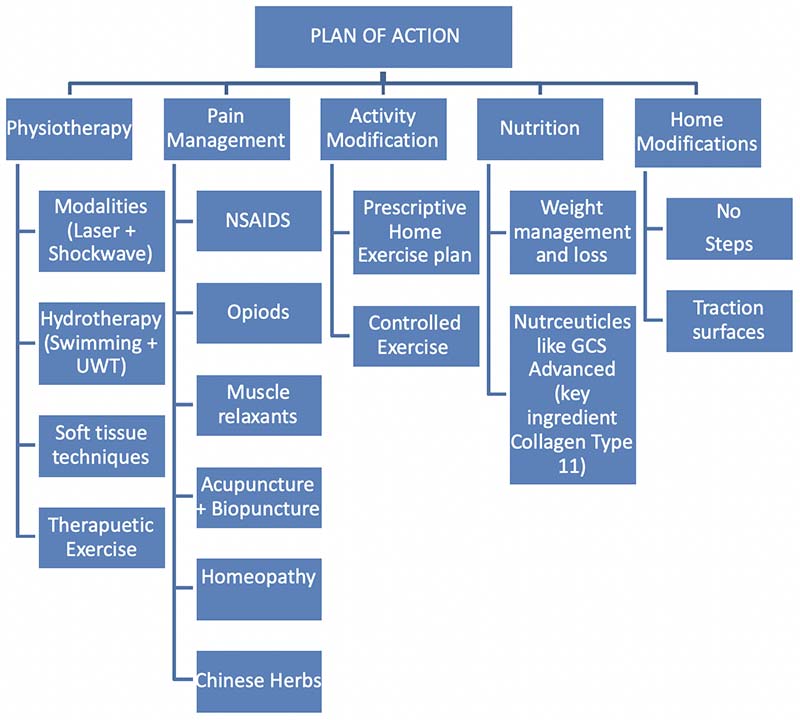
Goals of physiotherapy?
- Decrease pain levels
- Decrease compensatory muscle pain and tightness
- Maintain ROM
- Increase and/or maintain function
- Address neurological signs and loss of function
- Prevent muscle atrophy and increase muscle mass
- Provide a structured exercise plan
- Provide advice regarding home modification, diet changes and weight management
How can you assist your geriatric pet?
Osteoarthritis (OA)
- Osteoarthritis is also called degenerative joint disease and it an abnormality which involves degeneration of the cartilage as well as the subchondral bone.
Is my pet at risk?
- All pets can develop OA however, the following pets may be predisposed:
- Older pets
- Pets that lived a very active lifestyle
- Pets that have an existing pathology
- Some pets may have a genetic predisposition
How will I know if my pet has OA?
- Stiffness, especially in the morning
- Decreased activity level
- Struggling with normal activities of daily living
- Worse on wet and cold days
- Slight improvement with low impact exercise
What can I do to assist my pet?
- Pain management
- Nutraceuticals
- Physiotherapy
- Home adjustments
- Activity management
- Weight management
- Quality of life questionnaire
Physiotherapy
- Aids in decreasing pain
- Helps maintain function
- Regular treatment will enable the physiotherapist to pick up on early signs of disease progression.
Home adjustments

Activity management
- Short frequent walks are important for the management of OA
Quality of life questionnaire
- Canine brief pain index
- Glasgow composite pain scale
- Helsinki chronic pain index

If you need any assistance or have further questions please don’t hesitate to contact us!
What is Myasthenia Gravis?
- The neuromuscular junction is the junction between the nerve and the muscle.
- At this junction there is neurotransmitters (acetylcholine) which is responsible for the transmission of signals from the nerve to the muscle
- Myasthenia gravis is a deficiency in acetylcholine receptors on the muscle – this results in a disruption of the transmission of signals.
- Seen in Jack Russell Terriers, Springer spaniels, Smooth fox Terriers and Dachshunds.

Causes:
- Acquired – immune mediated destruction of acetylcholine receptors
- Congenital/ Hereditary
Signs and symptoms?
- Muscular weakness
- Decreased muscle tone
- Affects their breathing
- Can develop complications like pneumonia
Treatment options:
- Supportive care
- Immunosuppressive therapy
- Physiotherapy
- See flow chart of what physiotherapy may include
- Prognosis depends on the severity

Goals of physiotherapy?
- Decrease pain levels
- Decrease compensatory muscle pain and tightness
- Maintain ROM and function
- Address hind limb weakness if present
- Prevent muscle atrophy and increase muscle mass
- Provide a structured exercise plan
- Provide advice regarding home modification, diet changes and weight management
What is it Osteoarthritis?
- Degenerative joint disease (DJD)
- Deterioration of joint health that occurs secondarily to incongruity, instability or disruption of the articular cartilage
- Mechanical and biochemical changes that occur within the joint result in decreased cartilage resiliency, cartilage thinning, Subchondral bone sclerosis, osteophyte formation.
- Arthritis is inflammation of a joint
- Osteoarthritis is changes in bone

Signs and symptoms
- Joint pain
- Stiff
- Effusion (inflammation of a joint)
- Crepitus (crunching in the joint) is bone on articular cartilage
- Enlarged joint
- Lameness
- Decreased activity
- Loss of muscle mass and strength
- Change in behaviour
Treatments available
- There is no cure to arthritis. Management is key in maintaining the condition and slowing the progression of the disease
- Pain management
- Weight management
- Vigorous activity should be limited
- Lifestyle modifications – housed in a warm, dry area with good footing; padded area for sleeping and ramps for stairs
- Animal should be assessed routinely.
Physiotherapy goals
- Pain management
- Strengthen periarticular muscles
- Limit excessive stress on joints
- Maintain/improve ROM
- Maintain/improve cartilage
If you need any assistance or advice please don’t hesitate to contact us!
Puppies and Exercise Therapies

Congratulations on your new fur baby! This article is to provide information on your new puppy and questions you may have been asking.
We will be discussing:
- How much to exercise your puppy
- Fun exercises to do at home
- Why physiotherapy is important to puppies
How much to exercise your puppy
- It’s funny cause I typed into google “how should I exercise…” and “my puppy” is 5th on the list. So this is quite a common thing that people would like to know.
- Puppies can not exercise as much as an adult dog
- In puppies, they are growing a developing so naturally there is a concern for how much exercise to do with them.
- You need to take into consideration the age of your puppy as well as the breed.
- For example: A 10 week old puppy vs. a 6month old puppy will be able to do more than the 10 week old puppy.
- The larger breed dogs take longer to mature than smaller breeds.
- Basically, it is safe to say that at 2 years of age, any breed will be mature.
- Another example: a border collie puppy vs. a bull dog puppy. A border collie may manage to do more than a bull dog of the same age.
- Breed specific orthopaedic conditions need to be taken into consideration as well.
- Last thing, is are you planning on neutering you puppy and at what age?
- The reason to consider this is, if you neuter them under the age of 18month, this slows down the rate of the growth plates closing and therefore need to be cautious of exercise for a wee while longer.
- There is not a lot of research on this topic but, it is safe to say that waiting until your dog is fully mature is advised when it comes to their musculoskeletal system
- As you can see there are many aspects to exercise as well and not just taking for walks or chasing a ball.
- Mental stimulation is just as important in puppies.
- You will find that 5min of mental work will exhaust them!
- Our main reason for concern from a physiotherapy perspective is that we don’t want to overstrain their developing musculoskeletal system as this may lead to injury and other orthopaedic issues later on in their adult life.
- We want to prepare their bodies within reasonable limits for their future task or routine.
- Free rein in the garden is allowed!
- But if you have an older dog, it is important to observe and make sure that they aren’t rough with your new baby in the family.
- Short play dates with other dogs. If it is an older boisterous puppy, be cautious as you do not want them to be too rough with your wee one
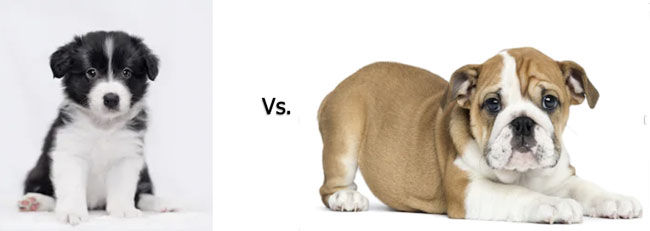
Exercise recommendation time scale
Age | Lead training | Garden | Mental work |
8-12 weeks | 5minute walking building up slowly to 15minutes | ADLIB | 5minutes EOD |
3 – 6 months | 20minutes building up slowly to 30minutes | ADLIB | 10minutes EOD |
6-12months | 30minutes building up slowly to 60 minutes | ADLIB | 15 minutes EOD |
- Physiotherapists will recommend a harness
- As all their soft tissue structures are still developing and we would not want to cause potential damage to these.
- It is also believed that it helps teach your dog not to pull.
- Mental work for your puppy could be teaching your dog exercises, playing brain games.
- Below are a list of exercises you can do with your puppy.
- You can use treats for these exercises but, be careful not to give too much and make sure it is a healthy option.
- Weight management begins at an early age!
1. Standing square | Getting your puppy to stand square and hold that position then give the treat. Repeat |
2. Sit/stand | Asking your puppy to sit nice and square. Treat. Then ask them to stand (VERY IMPORTANT). Treat. You can use ‘up’ or ‘stand’ as a verbal cue |
3. Sit/stand/lie down | From the sit get them to follow the treat with their nose down to the floor and say ‘down’ |
4. Giving paw | Ask them this by initially picking up their paw and saying paw a few times. Then try just with the verbal que. |
5. Cookie stretches | Getting your puppy to stand and ask them with a treat to stretch their head to their hip. Treat. Repeat the other side |
6. Touch | Practice getting your dog to touch different objects. Start with a large container and make the object smaller and smaller. Start this by saying touch and pointing to the object. Be patient they will eventually get its. |
7. Cavalettis (To from 3months) | Having poles on the ground and getting your puppy to walk up and down them |
8. Super stands (To from 3months) | Once they have the touch in place. You can have a chair and say touch. Get them to place their paws on the chair and balance there. You can then teach them ‘’down’ where they go down on their elbow and then ‘up’ on to their paws |
Why physiotherapy for puppies?
- Physiotherapy can be beneficial to even puppies
- We can keep an eye on their development
- Pick up on any developmental problems with regards to the musculoskeletal system early on before they are difficult to manage
- It allows them to socialize with other people which can prevent separation anxiety
- It allows them to be confident and comfortable with us
- It desensitizes them to touch them all over their body which can help a vet or ourselves evaluate them
- It aids in mental stimulation
- It enables them to learn in a different environment
- We can desensitize them to water
- Allow them to experience water in a positive experience and avoiding fear of water
- As they become older an if a musculoskeletal disorder arises, they already know what physiotherapy and hydrotherapy involves.
- This adds less stress to your pet that is most likely in a lot of pain.

We also love puppies and would love to spend time with them.
If you have any concerns about your puppy please don’t hesitate to contact us. We are more than happy to help you.
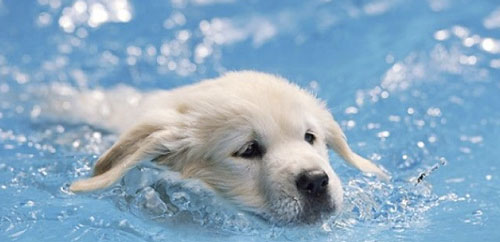
What is tetanus?
- Uncommon in dogs and cats
- Caused by a bacteria clostridium tetani that is introduced into the body through open wounds
- It releases a neurotoxin which inhibits the release of neurotransmitters at the synapse between the spinal cord and the brain.
- Resulting in increased muscle tone and spasticity
Signs and symptoms?
- Progressive stiffness of muscle
- Whole body muscle spasms
- Hypersensitivity to touch, light and sound
- Difficulty opening mouth
- Difficulty eating
- Difficulty breathing
- Excessive drooling
- Fever
- Paralysis
- Constipation
Treatment options:
- Veterinary care
- Antibiotics
- Sedation
- Muscle relaxants
- Wound treatment
- Physiotherapy
- See flow chart of what physiotherapy may include

Goals of physiotherapy?
- Decrease pain levels
- Decrease compensatory muscle pain and tightness
- Maintain ROM and function
- Address hind limb weakness if present
- Prevent muscle atrophy and increase muscle mass
- Decrease muscle tone
- Provide a structured exercise plan
- Provide advice regarding home modification, diet changes and weight management
- Limb amputation is usually performed as a last resort as a result from severe trauma or severe disorder to the limb.
- It can be skeletal, neurological or neoplasia.
- Dogs and Cats generally do well after amputation.
- Some patients even learn to walk with two legs without assistance but, it is advised that they are given support
General considerations
- The other limbs should be thoroughly assessed before amputation as pre-existing conditions in the remaining 3 or 2 limbs will be exacerbated.
- Strain on the remaining limbs are great
- Most patients suffer from pain in their backs as they rely on this area more for movement
- Some patients may need assistance and a custom cart may be needed to support them
- High risk of strain can occur in the contralateral limb as the unaffected limb is going to weight-bear more to compensate due to not having another limb to share the weight
- Amputees tend to compensate in their lats muscle and pull themselves with this muscle
- Weight is an important consideration as this will put more strain on your pet and they will difficulty adjusting and adapting to the amputation
- Weight gain after an amputation should be avoided as this can further stress the skeletal system and puts your pet at risk of further injury
- Prosthetic limbs are not ordinarily used in pets as they tend to adapt very well
- If you are considering using a prosthetic its should be fitted specifically to your pet
- It cannot be used at all times of the day as this can create pressure sores and will cause excessive stress on the patient
- It needs to monitored for skin breakdown and wounds
- Should be used for active periods of the day
- Taken off for rest periods of the day
- Bone prosthetics are not commonly used as it has a high risk of infection and is not usually a recommended course of action
Physiotherapy
Should begin on the first post-operative day with regards to pain management and supportive standing
Physiotherapy and hydrotherapy should be a contributing factor for the remainder of your pets lift
It enables them to exercise without compensation
It frees the joints and allows full ROM in the bodies joints whereas they would not be doing so when compensating for a missing limb
We get to monitor the health of your pets other limbs and can act fast and effectively if they are coming in at regular intervals.
All amputee should have a physiotherapists
Goals as a physiotherapist for their amputee patients
- Decrease pain
- Prevent injury and strain in other limbs
- Maintain ROM
- Manage compensatory pain
- Ease adaption of the missing limb
You will have received the following forms to help you with your amputee pet.
- PROM
- Heat vs Ice
- Stretching
- Massage
- Walking exercise
Exercises to do at home and incorporate in the above management
Beginner | |
1. Weight shifting | support hind/front quarters on both sides while gently shifting weight from one side to the other. Support pelvis and slowly push to one side while supporting the other side. Change direction and repeat exercise. Get your dog to stand square then place your hands on your dogs shoulders and gently push their weight back on to their HL Initially movements should be slow and rhythmic, as balance improves unbalancing movements can become faster Additional challenges can then be added. Place hind/front quarters on unstable surface such as hot water bottle, pillow, trampoline, blow up mattress and do some weight shifting exercises. As they become use to this weight can gently be shifted to side without supporting opposite side. |
2. Standing square | Get your dog to stand absolutely square and gently get them to move their head without moving their body with a treat |
3. Assisted sit/stand | Prompt patient to sit but on your lap or a cushion (raised platform) and then to a stand. Then work up to and sit/stand |
4. Sit stand | prompt patient to sit (helps when a treat is involved, low calorie of course) and make sure legs are in the correct position. Let patient stand, reposition feet if knuckling. When this exercise is mastered, sit to stands can be done on an unstable surface such as blow up mattress or on a pillow. |
Intermediate | |
5. Super stands | Get your dog to place their FL on a chair and stand square like this. Then gentle encourage head movement without them moving the rest of the body You can then ask them to stand on just their paws and then go down on their elbows. Repeat |
6. Uphill inclines | Start with a mild incline and gradually build up from there |
Advanced | |
7. Turning exercises while standing | while patient is standing encourage turning or stretching to flank with positive reinforcement. Concentrate on the weaker side. With your patient standing and you on one side of animal, move the treat slowly in the direction of the tail, encouraging them to only turn the head. This will require animal to bend body into a C shape. Hold position for 10 seconds, then step to the other side and repeat the exercise. |
8. Circling/ figure 8s | Start with exercise 7. Then guide your dog with a treat into doing a full circle Progress to figure of 8s when strong enough. |
9. Diagonal leg lifts | If your pet is a tripod, you can do this exercise Get your dog to stand square. The diagonal limb to the amputated limb and hold this position for 3-5s. Repeat |
Only 2-3 exercises per session. If you notice any lameness or discomfort with any of these exercises revert back to previous week’s level of activity or discontinue that exercise.
Why is it important?
- Obesity is the main cause of osteoarthritis in pets.
- Obesity leads to chronically high levels of inflammatory mediators in the body which in return accelerates the progression of osteoarthritis.
- Obesity leads to excesses weight on joints leading to increased wear and tear on joints
- Obesity is often associated with weakness, which can predispose your pet to musculoskeletal injury
- Obesity predisposes your pet to systemic issues eg. heart disease, respiratory compromise and diabetes

How do I know if my pet is overweight?
- An objective way to tell whether your pet is overweight is by using a body condition score index!
- Very Thin
- The ribs are visible to the eye with no fat covering it
- Underweight
- The ribs are visible with a little bit of fat coverage.
- Ideal
- The ribs can be felt easily with a slight layer of fat covering it. Ribs can only be seen as the bet moves.
- Overweight
- The ribs and bony areas are difficult to feel – covered in a fat layer.
- Obese
- Very hard to feel ribs and bony areas due to thick layer of fat.
Tips on how to manage your pet’s weight:
- Weight loss diet
- Hill’s metabolic
- Hill’s metabolic plus
- Raw diet
- Ask your veterinarian or veterinary physiotherapist to help you find the food best suited for your pet!
- Feed according to what they should weigh
- Feed according to your pet’s ideal weight
- Exercise (within the limits of their rehabilitation program)
- It is important that their output exceeds their input
- Low impact exercises that challenge their cardiovascular system
- Slow frequent walks to keep their metabolism active throughout the day
- Hydrotherapy!!!!
- Minimize treats
- Or replace treats with food that has low nutritional value eg carrots, cucumber
- Or use metabolic treats
- Keep track of what your pet eats (weigh food and/or write down what they eat)
- Subtract any treats given from their meals!



